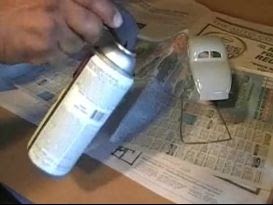Hi all; Sorry Monday was supposed to be Trains, and the schedule got 'derailed'. Will do better, promise. So we are going to go right to Wednesday: Models. (Although today's post can be used for trains too)
Today as per our website www.chinookandhobbywest.com, we are talking about Airbrush Terms. On our site we shared the difference between Single Action and Dual Action airbrushes. See our Hobby Talk page on our website if you haven't read it.
The MIX regarding airbrushes, refers to the way air and paint come together or 'atomize' while airbrushing. Airbrushes spray a series of dots (atomised material).
External Mix - air and paint mix outside the airbrush resulting in a coarse round spray pattern. This is preferred for larger surface coverage and volume spray applications.
Internal Mix - air and paint mix inside the airbrush creating a precisely atomised 'fine dot' spray pattern. This is preferred for precision finishing needs, like colour graduation, shading and fine lines.
The FEED refers to the place of entry and manner the paint enters the airbrush.
Bottom Feed - the paint enters through a syphon tube or colour cup attached to the bottom of the airbrush. This type of airbrush should have at least 18 PSI while spraying to operate properly. This is best used for general purpose. It uses the paint without having to frequently fill the cup. It also allows the artist to work at a faster pace when desired.
Gravity Feed - the paint enters at the top of the airbrush through a tip mounted colour reservoir. Gravity draws the material in to airbrush. This airbrush can be operated a as low as 8 PSI. This one allows the artist to slow down as gravity pulls the paint into the airbrush to improve the control of the airbrush. This makes it easier to do finer detail work as the finishing process can be done at a more deliberate pace. This is best for detail airbrushing.
Side Feed - the paint enters at the side of the airbrush through a side attached colour cup. This airbrush operates best at about 12 PSI. The swivel side cup allows more flexibility for airbrushing if difficult to reach areas or on contoured pieces. This is great for detail work because the side feed cup eliminates any sight line obstruction to the needle tip when doing 'close in' intricate detailing.
Dual Feed - this airbrush can be used as either gravity feed or bottom feed depending on your varying application needs. This type of airbrush is exclusive to Badger Air-Brush Co.
PSI - Pressure per square inch, the measurement of the level of air pressure.
Nozzle Sizes - There are so many choices for spraying and each has some effect on the line an airbrush produces. Nozzle sizes (Fine, Medium, Heavy or 1, 3 and 5) refer more to the paint sprayed through the airbrush than the fineness of line produced. The fineness of the line is determined by many factors - nozzle size, needle's linear air flow angel, pigment ratio of paint, pigment size, operating pressure, etc. NOTE: you must have the correct nozzle/needle size with the right paint for optimum airbrush performance.
Fine/1: sprays thin, low viscosity inks, water colours, dyes, stains, etc.
Medium/3: The most popular; sprays airbrush ready paints, properly thinned acrylics, lacquers, enamels and special applications such as tanning solutions, body paints, food airbrushing colours, etc.
Heavy/5: Best for heavily pigmented and high viscosity mediums such as glazes, gesso, latex and varnish.


No comments:
Post a Comment